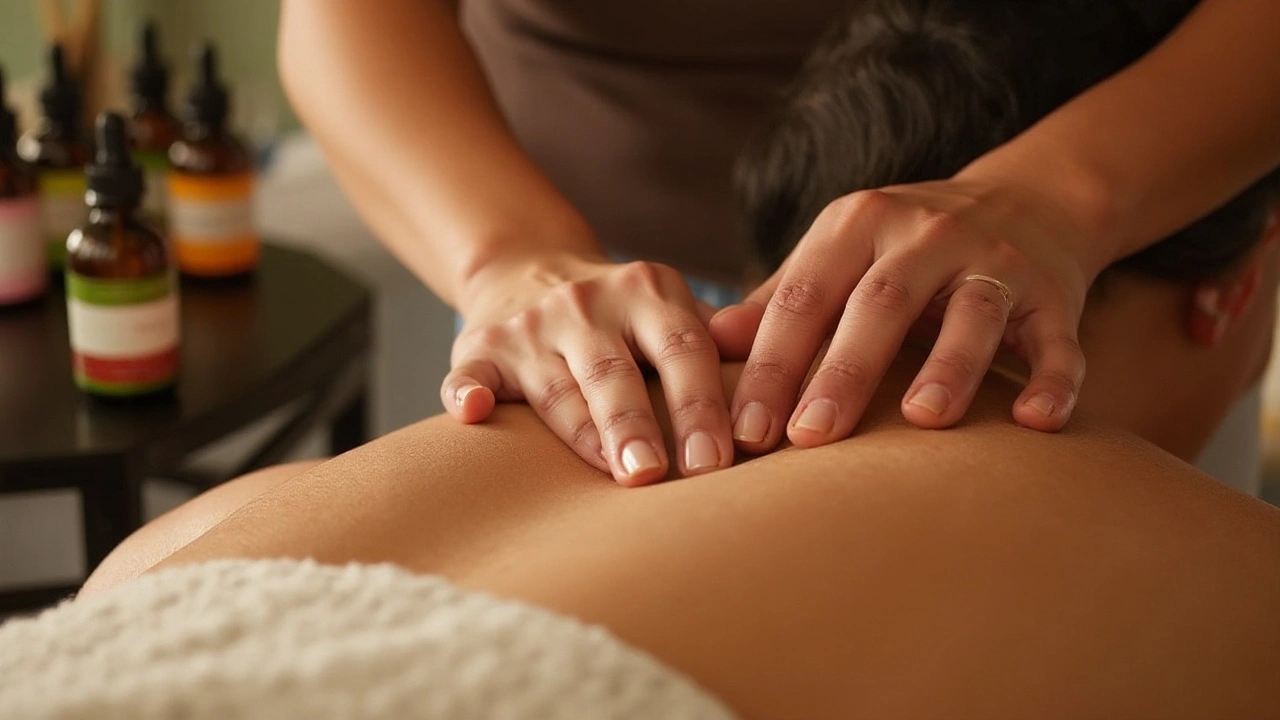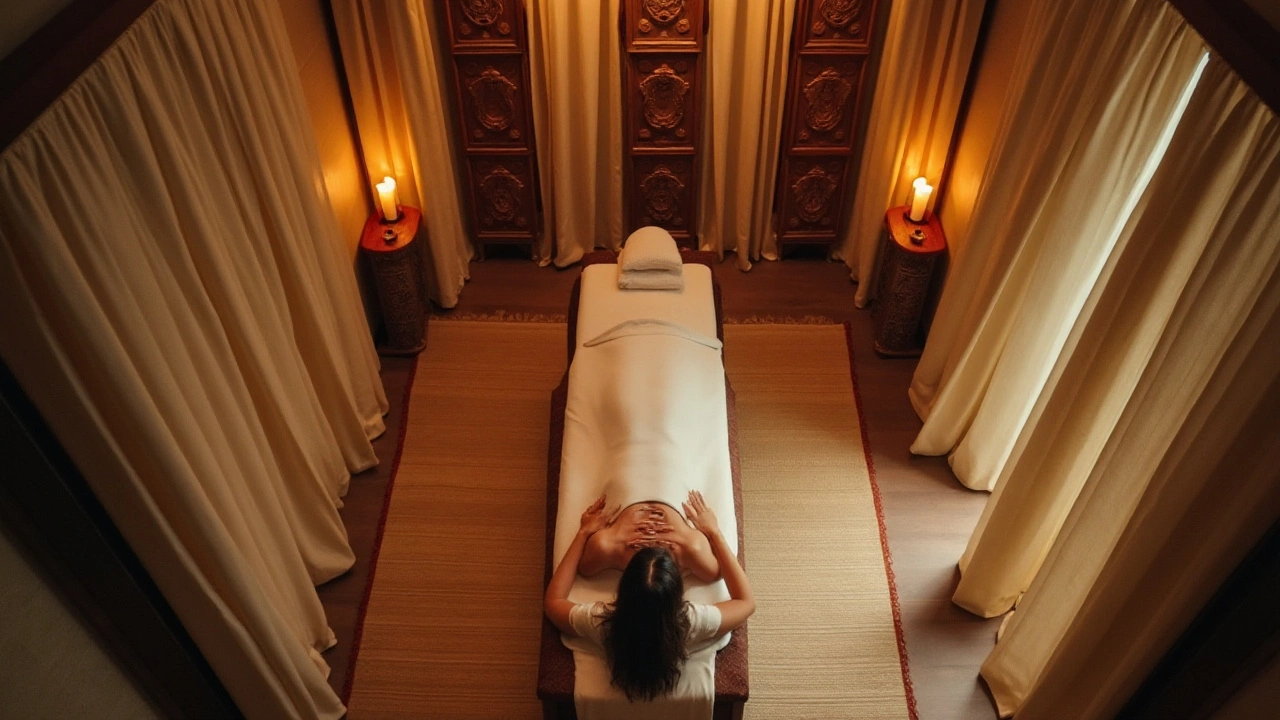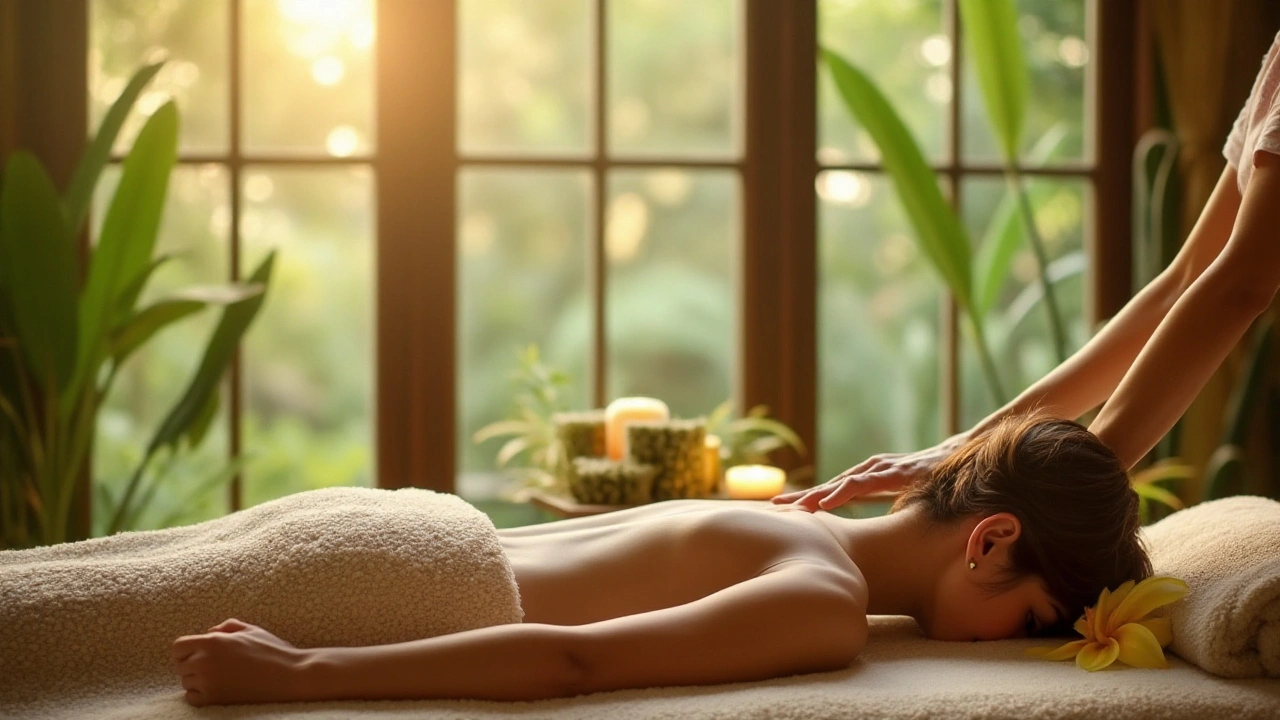Balinese massage, rooted in the rich traditions of Indonesia, is renowned for its ability to melt away tension and induce deep relaxation. This massage therapy melds a variety of techniques, including acupressure, reflexology, and aromatic therapy, which together create a powerful healing experience.
The art of Balinese massage is more than just physical; it is a journey towards restoring balance and harmony within the body. By integrating touch with the healing properties of essential oils, these massages provide not only relief from stress but also a renewal of energy.
In today’s fast-paced world, finding solace in such traditional practices can significantly impact mental and physical health. Understanding the specific methods used, and how they interact with the body, will open doors to greater well-being and a lifestyle filled with serenity.
- Understanding Balinese Massage
- Key Techniques and Their Benefits
- The Science Behind Stress Reduction
- Essential Oils and Their Therapeutic Roles
- Cultural Significance and Rituals
- Tips for Incorporating Massage into Your Routine
Understanding Balinese Massage
Balinese massage is a therapeutic practice originating from the Indonesian island of Bali. This exquisite form of healing unites ancient Indonesian techniques focused on achieving balance within the body. It combines methods of acupressure, skin rolling, and deep tissue massage to relieve stress and promote relaxation effectively. Each session aims to rejuvenate the body, heal emotional distress, and enhance spiritual harmony, making it an integral part of Bali's holistic health culture.
The unique blend used in Balinese massage includes not only physical manipulation but also elements of aromatherapy. Essential oils, often derived from tropical flowers and plants native to the region, play a crucial role in this therapy. These oils are chosen carefully to cater to the recipient's needs, be it relaxation or revitalization, making each treatment personalized and unique. The roots of Balinese massage can be traced to Ayurveda, the ancient Indian system of holistic health, which emphasizes balancing the body's energy systems.
A typical Balinese massage begins with a prayer-like ritual which aims to set a peaceful tone for the session. Clients lie down on a comfortable massage table as the therapist begins with long, flowing strokes over the back, gradually applying more pressure with the use of fingers, palms, and occasionally elbows. Throughout the session, the expert use of essential oils and aromatherapy diffuses into the room, enhancing the relaxation process and allowing the client to ease into serenity. According to a study published in the Journal of Alternative and Complementary Medicine, regular sessions of Balinese massage can significantly lower stress hormone levels.
The Techniques and Their Benefits
The techniques employed in a Balinese massage are meticulously structured to provide maximum benefits. Acupressure targets specific points across the body to alleviate tension, promoting optimal circulation and the release of toxins. This aspect alone has been praised for contributing to improved energy flow and greater bodily relaxation post-massage. Skin rolling helps in loosening tight tissues and improving blood flow across the skin, making it a vital component for enhancing skin vitality.
Stress reduction is achieved when these techniques are applied in tandem with scientific approaches that cater to promoting flexibility and easing muscle knots. The incorporation of reflexology also plays an essential role. While similar to acupressure, reflexology focuses on stimulating specific points on the feet and hands. It has been globally recognized for helping in managing stress and improving overall health. One therapist from Ubud, a well-known cultural hub in Bali, quipped, “The magic lies not just in the touch but in the ancestral wisdom passed down through generations.”
The benefits of Balinese massage span both the physical and metaphysical realms, representing more than just a temporary escape. It acts as a gateway to experiencing a state of mindfulness and profound peace, proving itself invaluable in maintaining long-term wellbeing and aligning with Bali's deep-seated spiritual traditions. For those seeking refuge in wellness resorts across the world, the mark of authentic Balinese practices remains an alluring feature in achieving personal health goals.
Key Techniques and Their Benefits
Balinese massage is an artful blend of acupressure, skin rolling, and firm strokes, meticulously combining these techniques to target stress and promote relaxation. The massage begins with acupressure, where specific points on the body are pressed with varying degrees of pressure. This is aimed at releasing blockages and enabling the flow of energy, effectively reducing stress levels and enhancing relaxation. By targeting pressure points, such as those on the feet and back, the tension is alleviated, and circulation is improved. Skin rolling, another integral technique, involves gently lifting and rolling the skin; this not only warms the muscles but also helps improve lymphatic drainage and detoxification. This process aids in flushing out toxins from the body, leaving you feeling revitalized.
The role of firm strokes in Balinese massage cannot be overstated. These long, sweeping strokes work deeply into the muscles, addressing aches and releasing built-up tension. Utilizing palm and thumb pressure, this method is particularly beneficial for those experiencing muscle soreness or stiffness due to prolonged sitting or physical activity. With regular sessions, one may notice improved flexibility and a reduction in muscle fatigue, contributing to a more agile and relaxed body. According to a study conducted by the Indonesian Journal of Health Research, regular Balinese massage sessions resulted in a 50% reduction in stress levels among participants, underscoring its efficacy.
Acupressure and Its Benefits
Acupressure is central to the effectiveness of Balinese massage. This technique not only promotes relaxation but also works to restore balance to the body's energy. Practitioners believe that applying pressure to specific points can improve the function of organs and systems, offering relief from various ailments. It enhances mental clarity and emotional stability, making it a holistic approach to wellness. The pressure applied during a session can be tailored to the individual's needs, accommodating any preferences for lighter or more intense touch.
"It's not just about physical relaxation," says Dr. Maria Iptum, an expert in traditional Indonesian therapies. "Balinese massage integrates mental and emotional well-being, creating a comprehensive path to health."
By understanding and harnessing the power of these traditional techniques, anyone can experience significant improvements in both physical and mental wellness. Incorporating a regular Balinese massage into one's routine can thus serve as a powerful tool for not only reducing stress but also enhancing one's quality of life.

The Science Behind Stress Reduction
Engaging in regular sessions of Balinese massage can offer more than just temporary relaxation; it engages our body's deeply rooted biological mechanisms. At the core of stress, the fight or flight response often leads to elevated levels of stress hormones like cortisol and adrenaline. These hormones, when persistently elevated, can harm your body and lead to issues such as high blood pressure and muscular tension. When a client undergoes a Balinese massage, it can trigger physiological responses that counteract this.
The techniques used in Balinese massage—such as kneading and acupressure—stimulate the central nervous system. This stimulation signals the brain to release neurochemicals like serotonin, which play a crucial role in mood stabilization and stress reduction. Serotonin works by binding to receptors in the brain, reducing feelings of anxiety and promoting a sense of calm and relaxation. The inclusion of aromatherapy with essential oils in these massages can also enhance these effects by activating the olfactory system and influencing the second layer of the brain associated with emotion processing.
A particularly fascinating aspect of Balinese massage is how it influences heart rate variability (HRV), a measure of the variation in time between heartbeats. Higher HRV is associated with a relaxed state and a robust ability to adapt to different stressors. A study from the International Journal of Neuroscience pointed out that therapeutic massage could significantly improve HRV, signaling reduced stress levels.
"Massage therapy has potential benefits for both the mind and body, encouraging a decrease in stress markers and an increase in immune function," suggests the Mayo Clinic.
The Role of Essential Oils
Incorporating essential oils into the massage amplifies its stress-relieving properties. Different oils have unique benefits. For example, lavender oil is widely known for its anxiolytic properties, helping to soothe and calm the mind, while ylang-ylang can reduce blood pressure and ease tension. Research suggests that inhaling essential oils can impact brain wave activity and decrease stress hormone levels.A table illustrating a few commonly used essential oils and their associated benefits during a Balinese massage might look like this:
| Essential Oil | Benefits |
|---|---|
| Lavender | Calming, reduces anxiety and depression |
| Eucalyptus | Refreshing, relieves mental exhaustion |
| Ylang-Ylang | Lowers blood pressure, alleviates tension |
While the physiological benefits are clear, the psychological effects should not be underestimated. The serene environment typical of a Balinese massage, filled with calming scents and soothing sounds, encourages mindfulness and can lead to a meditative state. Regular practice not only helps in managing stress levels but also promotes a holistic sense of wellbeing, making Balinese massage an essential component of a balanced lifestyle.
Essential Oils and Their Therapeutic Roles
In the practice of Balinese massage, the use of essential oils stands out as a quintessential element, each adding its distinct aromatic and therapeutic efficacy to the experience. These potent oils, extracted from various parts of plants like flowers, leaves, and roots, have been celebrated across cultures for their ability to enhance physical and emotional well-being. Delving into their role during massage sessions, it's crucial to understand the science and subtleties that these oils bring into play. Lavender, for instance, is renowned for its calming properties, often included for its ability to relax both the muscles and the mind. Its sweet, floral scent is scientifically shown to reduce anxiety and even induce sleep, making it a favored choice for those battling with stress-related insomnia.
Another popular option is eucalyptus oil, which is appreciated for its invigorating aroma and anti-inflammatory properties. This essential oil is particularly beneficial during the cooler months, as it helps in clearing the respiratory system and boosts immunity. Such oils are also adept in alleviating muscle pain and stiffness during a Balinese massage, aiding in not only relaxation but recovery as well. Each session carefully selects oils based on their therapeutic attributes, aligning them with the client's needs. A 2012 study published in the International Journal of Neuroscience noted significant improvements in sleep quality and mood following massages that incorporated such aromatic elements.
"The power of essential oils lies in their ability to reach deep into our limbic system, influencing our emotions and mood," says Mary Wallis, a renowned aromatherapist.
The intricate synergy of these oils with massage techniques like acupressure and kneading amplifies the stress reduction effect significantly. By stimulating the skin and the olfactory system simultaneously, essential oils promote a multisensory healing experience. When clients inhale scents like lemongrass or ylang-ylang, they often report not just physical relaxation but also mental clarity. The oils’ chemical constituents connect to the joy-centric receptors in the brain, offering instant relief from negative emotions. Healers often emphasize how these oils contribute to creating an environment that feels both sacred and soothing, offering much more than just scent.
For at-home users hoping to recreate the spa-like relaxation experience, understanding how to effectively blend and apply these oils is key. Common practices involve diffusing a mixture of calming and uplifting oils or creating a personalized blend to target specific emotional or physical needs. It is recommended to consider skin sensitivity and undertake a patch test before extensive use. Some enthusiasts invest in a small selection of versatile oils like sweet orange, sandalwood, and chamomile to mix and match according to desired outcomes. By incorporating these natural antidotes into daily life, individuals can enjoy an almost seamless transition from stress to tranquility, albeit within the comforts of their own space.

Cultural Significance and Rituals
The traditional practice of Balinese massage has deep roots in the rich cultural tapestry of Bali, an island that has long been a beacon of unique cultural rituals and a destination for seekers of tranquility. This massage modality is not simply a physical technique but an integral part of Balinese culture, steeped in traditions that emphasize balance, spirituality, and connection to nature. Known for its holistic approach, Balinese massage reflects a way of life where physical touch is not only a form of therapy but a spiritual journey towards healing the mind, body, and soul.
Every Balinese massage session begins with a profound sense of ceremony. Before any therapeutic touch is applied, practitioners often perform a prayer or a moment of reflection to honor their ancestral roots and set an intention for healing. This ritualistic beginning transforms a simple massage into a spiritual experience, reminding both therapist and receiver of the sacred journey they embark upon. Such customs echo the Balinese philosophy of Tri Hita Karana, which emphasizes the three causes of well-being: a harmonious relationship with God, people, and nature.
In Bali, embracing these practices often includes the use of traditional music and incense, which are believed to enhance relaxation and open one's spiritual channels. The welcoming aroma of jasmine, sandalwood, or ylang-ylang drifts through the air as soothing Gamelan music plays softly in the background. This carefully curated sensory environment is designed to soothe the nervous system, enabling deeper relaxation and promoting a more profound release of tension.
For generations, remedies passed down through Balinese families have centered around herbal ingredients indigenous to the lush island. Ingredients such as galangal, turmeric, and kaffir lime are commonly integrated into massage oils or scrubs, combining physical therapy with the healing properties of nature. On special occasions or personal milestones, such treatments are elevated to ceremonial offerings — an act of gratitude and a wish for prosperity and health.
Beth McDougall, an expert in Southeast Asian cultural traditions, notes, "The sacredness imbued in Balinese massages is a testament to the people's resilience and deeply held beliefs about health and happiness, where physical touch transcends into a universal language of care."Balinese massage is also emblematic of the island's hospitality. Widely practiced in local homes and high-end spas alike, it represents the warmth and familial affection that are characteristic of Balinese interactions. As the practice gains international recognition, the spirit of Balinese massage continues to enchant, offering a taste of its cultural richness to those who seek it worldwide, while maintaining its tranquil allure and therapeutic essence.
Tips for Incorporating Massage into Your Routine
We often overlook our own well-being in the hustle and bustle of daily life. Integrating Balinese massage into your routine can be a powerful antidote to stress. Start by setting a regular schedule for your massage sessions. Whether once a week or bi-weekly, consistency can notably amplify the relaxation benefits. By establishing a routine, your body starts to anticipate the massage, allowing you to unwind more quickly and deeply during each session.
Choosing the right time for a massage plays a significant role in the effectiveness of the therapy. For many, evenings work best as it allows you to decompress after a long day and prepare for restful sleep. However, some might find mornings ideal to energize and start their day on a refreshing note. Experiment with different times to find what suits your lifestyle and rhythm best. Remember, the surrounding ambiance is crucial to a relaxing massage session. Create a serene environment with dim lighting, calming music, and fragrant essential oils to enhance the massage experience.
Moreover, incorporating self-care habits alongside stress reduction techniques enhances the overall impact. Gentle stretching exercises or a brief meditation session before a massage can help relax your muscles and clear your mind. Also, staying hydrated is vital, as massages increase circulation and help detoxify your body. Drinking water before and after your session supports this process, boosting the benefits you receive.
As the well-known wellness expert, Deepak Chopra, says, "The way you think, the way you behave, the way you eat, can influence your life by 30 to 50 years."
Understanding the different techniques used in Balinese massage can also empower you to select the right focus for each session. Communicating with your therapist about your stress points or areas requiring attention can personalize the experience to cater more effectively to your needs. Be honest about any discomfort, as that ensures the therapist can adjust their techniques accordingly. Additionally, don't limit yourself to a professional setting. Consider learning basic techniques for self-massage, like working on common tension areas around your neck, shoulders, and feet.
Trying out different variations and add-ons can diversify your experience and keep your routine exciting. Explore the use of herbal compresses or incorporate aromatherapy to deepen the relaxation. Some may find value in alternating between Balinese massage and other forms like Swedish or deep tissue to target specific issues. Creating a well-rounded approach not only keeps the procedure fresh but enhances the holistic benefits to your physical and mental well-being.
Lastly, if integrating regular sessions might seem a challenge due to time or budget constraints, consider group packages or discounted memberships many spas offer. These deals make it more feasible to stick to a routine without breaking the bank. Balinese massage, with its unique blend of techniques, can be a delightful ritual that fits seamlessly into your life, offering relief and rejuvenation, helping you face the world with newfound calmness and vigor.

